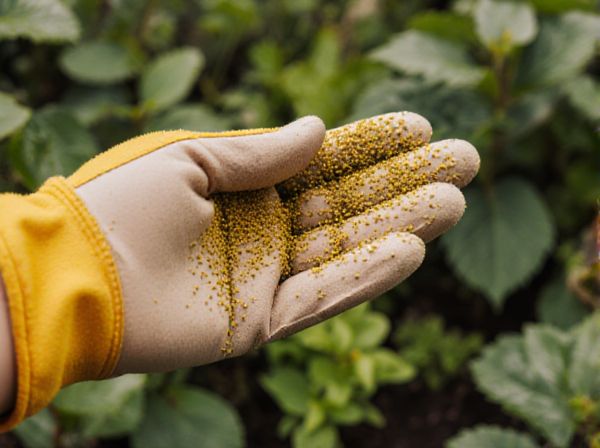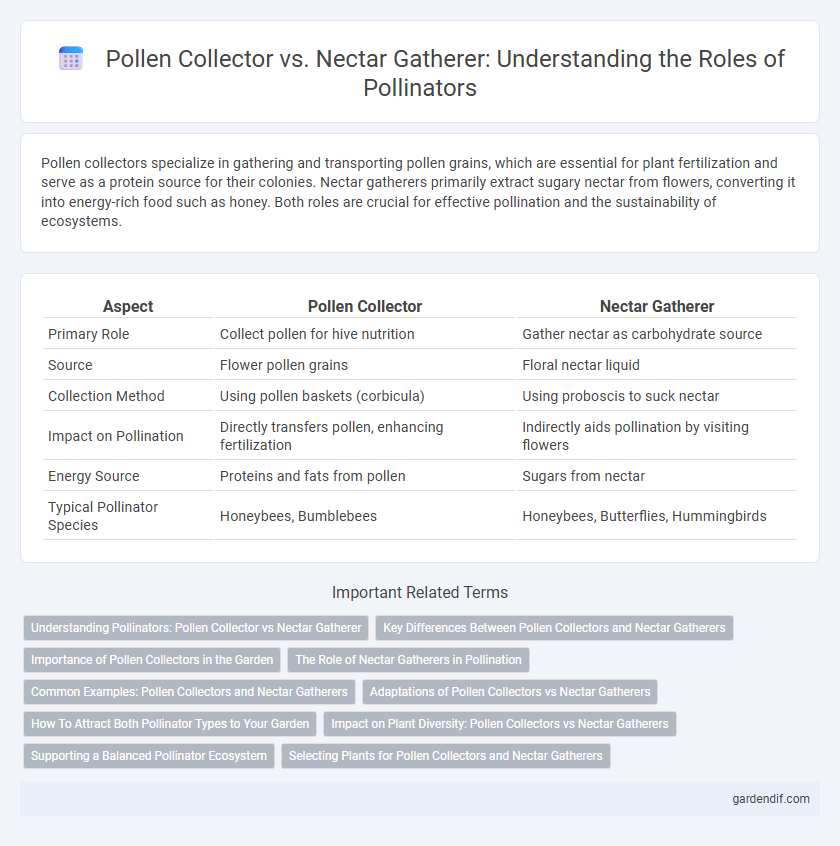
Pollen collector vs Nectar gatherer Illustration
Pollen collectors specialize in gathering and transporting pollen grains, which are essential for plant fertilization and serve as a protein source for their colonies. Nectar gatherers primarily extract sugary nectar from flowers, converting it into energy-rich food such as honey. Both roles are crucial for effective pollination and the sustainability of ecosystems.
Table of Comparison
| Aspect | Pollen Collector | Nectar Gatherer |
|---|---|---|
| Primary Role | Collect pollen for hive nutrition | Gather nectar as carbohydrate source |
| Source | Flower pollen grains | Floral nectar liquid |
| Collection Method | Using pollen baskets (corbicula) | Using proboscis to suck nectar |
| Impact on Pollination | Directly transfers pollen, enhancing fertilization | Indirectly aids pollination by visiting flowers |
| Energy Source | Proteins and fats from pollen | Sugars from nectar |
| Typical Pollinator Species | Honeybees, Bumblebees | Honeybees, Butterflies, Hummingbirds |
Understanding Pollinators: Pollen Collector vs Nectar Gatherer
Pollen collectors actively harvest pollen grains, which serve as protein-rich food essential for their larvae, often transporting pollen using specialized body parts like scopae or pollen baskets. Nectar gatherers primarily seek nectar, a sugary fluid providing immediate energy, using long proboscises to access flower nectaries without necessarily collecting pollen. Understanding the distinct roles of pollen collectors and nectar gatherers helps optimize plant-pollinator interactions crucial for effective crop pollination and biodiversity conservation.
Key Differences Between Pollen Collectors and Nectar Gatherers
Pollen collectors are specialized pollinators that gather pollen grains for protein-rich food, often exhibiting adaptations like branched body hairs to trap pollen effectively. Nectar gatherers primarily extract nectar, a sugary liquid, serving as an energy source and facilitating pollination through flower visits without significant pollen transport. Key differences lie in their anatomical traits, resource preferences, and roles in pollination dynamics, with pollen collectors directly moving pollen while nectar gatherers mainly aid in cross-pollination indirectly.
Importance of Pollen Collectors in the Garden
Pollen collectors play a crucial role in garden ecosystems by facilitating the transfer of pollen between flowers, which enhances plant reproduction and biodiversity. Unlike nectar gatherers that primarily seek nectar for energy, pollen collectors actively gather and distribute pollen, ensuring successful fertilization and seed production. Their activity supports the growth of fruits, vegetables, and flowering plants, making them indispensable for a thriving and productive garden.
The Role of Nectar Gatherers in Pollination
Nectar gatherers play a crucial role in pollination by visiting flowers to collect nectar, inadvertently transferring pollen between blossoms, which aids in plant reproduction. Unlike pollen collectors that actively harvest pollen for food, nectar gatherers contribute to cross-pollination by brushing against the anthers and stigmas while feeding. This process enhances genetic diversity and supports ecosystem stability by promoting the growth of fruit and seed-producing plants.
Common Examples: Pollen Collectors and Nectar Gatherers
Pollen collectors such as honeybees and bumblebees primarily gather pollen, which is vital for protein intake and brood development. Nectar gatherers like butterflies and hummingbirds focus on extracting nectar, a rich source of carbohydrates for energy. Both roles are crucial in pollination, facilitating plant reproduction and maintaining ecosystem biodiversity.
Adaptations of Pollen Collectors vs Nectar Gatherers
Pollen collectors possess specialized body structures such as branched hairs and scopae that efficiently trap and transport pollen grains, enhancing pollination effectiveness. Nectar gatherers exhibit adaptations like long proboscises and agile flight patterns, enabling access to deep floral nectaries for energy-rich nectar extraction. These distinct morphological and behavioral traits optimize resource collection while promoting plant reproductive success through effective pollinator-plant interactions.
How To Attract Both Pollinator Types to Your Garden
To attract both pollen collectors and nectar gatherers, plant a diverse array of flowering species that bloom at different times throughout the growing season, providing continuous food sources. Include native wildflowers, herbs, and flowering shrubs known to produce abundant pollen and nectar, such as coneflowers, lavender, and sunflowers. Creating habitats with sheltered areas and water sources enhances the garden's appeal to various pollinators, supporting their nutritional and nesting needs.
Impact on Plant Diversity: Pollen Collectors vs Nectar Gatherers
Pollen collectors directly influence plant genetic diversity by transferring pollen between flowers, facilitating cross-pollination and enhancing gene flow within plant populations. Nectar gatherers primarily affect plant reproductive success by attracting pollinators but contribute less to pollen transfer, resulting in limited impact on genetic variability. The distinct roles of pollen collectors and nectar gatherers collectively support ecosystem resilience through varying contributions to plant diversity.
Supporting a Balanced Pollinator Ecosystem
Pollen collectors such as bees transport protein-rich pollen essential for brood development and plant reproduction, while nectar gatherers like butterflies and hummingbirds primarily seek sugary nectar for energy, supporting diverse dietary needs across pollinator species. This functional differentiation promotes a balanced pollinator ecosystem by ensuring both pollination efficiency and resource partitioning, which reduces competition and supports biodiversity. Maintaining habitats rich in flowering plants with varied pollen and nectar profiles is vital for sustaining these complementary pollinator roles.
Selecting Plants for Pollen Collectors and Nectar Gatherers
Selecting plants for pollen collectors emphasizes species with abundant, accessible pollen such as sunflowers, asters, and clover, which provide essential protein for bee larvae and colony growth. Nectar gatherers benefit from plants rich in nectar like lavender, salvia, and foxglove, offering high-energy sugars crucial for adult pollinators' metabolism and flight endurance. Combining diverse flowering plants that bloom sequentially ensures continuous resources to support both pollen collectors and nectar gatherers throughout the foraging season.
Pollen collector vs Nectar gatherer Infographic

 gardendif.com
gardendif.com